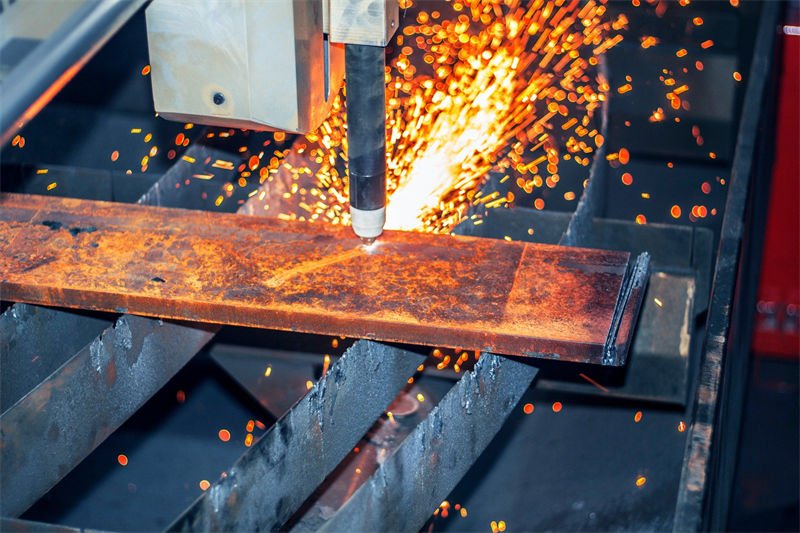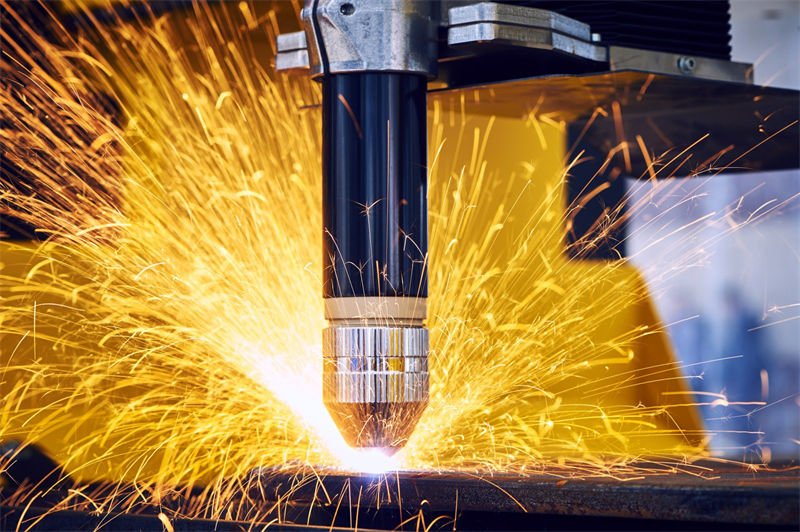
Do you ever think about why plasma cutting is so accurate? It isn’t magic alone – it comes from important factors working together.
Plasma cutting precision depends on factors such as torch movement control, ideal cutting speed and the right distance from the material. Using high-quality consumables is essential, too. Understanding these elements helps achieve smooth cuts with fewer flaws. Calibrating your equipment regularly is very important. Calibration is key for the best results.
I remember the first time I tried plasma cutting. It felt like walking on a thin rope during a strong wind. Controlling the torch seemed like ice skating over a rough pond. Every tiny move changed everything.
The next challenge was finding the right speed and standoff distance. Cutting too fast or too close created cuts that looked like abstract art. Maybe beautiful, but not what I wanted.
Consumables were another story! They felt like choosing the correct ingredients for cooking. They really decided if the project succeeded or failed. After several tries, I realized knowing these things wasn’t just about success. Mastering them turned my early chaos into true masterpieces.
Torch motion control is crucial for plasma cutting accuracy.True
Precise torch movement ensures consistent cuts, reducing errors.
Standoff distance doesn't affect plasma cutting quality.False
Incorrect standoff distances can lead to poor cut quality and defects.
How Does Torch Motion Affect Plasma Cutting Precision?
I remember the first time I realized how important torch motion is to plasma cutting. This discovery felt like finding the magic ingredient that turns a good meal into a fantastic one.
Torch movement influences plasma cutting accuracy by keeping the cut steady and quick. Precise control of the torch reduces mistakes. Cleaner and more precise cuts result from this.

The Role of Torch Motion in Precision
At first, I thought operating plasma cutters would be simple. However, torch motion is crucial, much like rhythm in dance. If absent, everything collapses. Speed, angle, and path are not mere words; they are key to achieving an ideal cut.
Once, I moved the torch too fast on a project. The result? Cuts were as rough as my nerves when I saw them. Another time, going too slowly caused warped material, similar to a cookie left too long in the oven. Very warped material.
| Torch Movement | Impact on Precision |
|---|---|
| Too Fast | Rough cuts |
| Too Slow | Warped material |
| Optimal Speed | Ideal cuts |
Factors Influencing Torch Motion
-
Speed Control: Changing torch speed keeps precision. Modern cutters allow fine adjustments, like switching bicycle gears based on terrain.
-
Angle Adjustment: Holding the torch at the right angle matters a lot. Like finding the best slope for a paper plane, a straight angle gives smooth edges that people really want.
-
Path Accuracy: Steady paths are really important. I tried a freehand cut once – results looked more like abstract art than precise work.
Technology Helping Control
With technology, we’ve probably left behind manual guessing days. CNC systems1 automate movement, keeping speed and accuracy steady. Also, advanced controllers2 give instant feedback, similar to GPS recalibrating after a wrong turn.
Knowing these parts changed my work. Precision improved in every cut. A CNC system for detailed plans reduced errors and improved work quality.
Torch speed affects plasma cutting precision.True
Speed control is crucial; too fast or slow impacts cut quality.
CNC systems decrease plasma cutting accuracy.False
CNC systems automate torch motion, improving precision and consistency.
How Does Cut Speed Influence Plasma Cutting Accuracy?
Have you ever thought about how changing one setting could improve your plasma cutting results? Let me show you the interesting world of cut speed and how it affects precision. Cut speed really matters. It changes everything.
Cut speed is very important in plasma cutting. It affects kerf width, edge quality and dross creation. The right speed results in precise cuts. Both too fast and too slow speeds can cause problems. These problems lead to bad quality.

Understanding Plasma Cutting Dynamics
Think of racing with a torch in your hand. Plasma cutting feels like a dance with a fast jet of gas, cutting metal with care. The speed you move the torch, or cut speed, is crucial. This balance between speed and accuracy is not just technical; it’s art. Finding this balance is important. Very important.
Impact on Kerf Width
Kerf width sounds technical, but it’s just how wide the cut is. I used to think faster cuts meant better results. Cutting too quickly led to unfinished pieces and uneven edges—like a rushed drawing with messy lines. Different speeds change your work a lot.
| Cut Speed | Kerf Width | Result |
|---|---|---|
| Too Slow | Wide | Excessive taper |
| Optimal | Balanced | Precision achieved |
| Too Fast | Narrow | Potential skips |
Influence on Edge Quality
I learned edge quality matters a lot. Fast speeds caused rough, jagged edges, while slower speeds resulted in smoother but wider edges. Finding the right speed is essential when you need perfect edges for superior edge finishes3.
Dross Formation Challenges
Dross, those annoying metal bits, can be frustrating. During early projects, I spent much time cleaning because my speed was off. With the correct speed, cuts became cleaner—saved time was valuable for other tasks by minimizing dross formation4.
Practical Considerations for Technicians
If you are a hands-on worker like Ferudun, knowing these details is helpful. Adjusting cut speed means not just better cuts but also longer machine life. When buying new cutting machines5, consider ones with adjustable speeds for different metals and thicknesses. This choice improves both quality and efficiency—really improves.
Higher cut speed reduces kerf width.True
Higher speeds remove less material, narrowing the kerf.
Slow cut speeds eliminate dross formation.False
Slow speeds increase dross due to excessive heat exposure.
Why is Standoff Distance Crucial for Plasma Cutting?
Did you ever think about what changes a good plasma cut into a great one? The answer hides in the small gap called standoff distance.
Standoff distance in plasma cutting is very important. This distance affects the quality of cuts. It also influences arc stability. Equipment lasts longer with proper distance. Smooth cuts happen this way. Less waste, known as dross, occurs.

Understanding Standoff Distance
At the start of my technician journey, the word ‘standoff distance’ confused me a lot. At first, it seemed small and unimportant. But soon I understood its effect on every cut. It’s the space between the nozzle and the metal. This gap changes everything for the better. When set right, the arc stays steady, cuts come out smooth, and the dross is very minimal.
Once, I placed the standoff distance too close while working on a project. It was a typical beginner’s error. The nozzle got overheated. Cuts looked cleaner, but the nozzle wore out fast. Another time, setting it too far gave me rough edges. This taught me to respect this tiny but powerful factor.
| Distance | Effect on Cut | Potential Issues |
|---|---|---|
| Too Close | Overheated arc, cleaner cut | Shorter nozzle life |
| Optimal | Stable arc, precise cut | Maximizes consumable life |
| Too Far | Weaker arc, rough edges | Incomplete cuts, increased dross |
Reaching Optimal Standoff Distance
Through many trials and mistakes, hitting the right standoff distance felt like finding the perfect spot in a recipe. Material thickness and machine details are important to consider. Most cutting machines come with suggested guidelines; however, similar to adjusting spices, fine-tuning settings can really improve the outcome.
Regular maintenance became really important to me. Frequent cleaning and checks helped keep the perfect gap and stopped unexpected changes. I also learned about height control systems. These systems were a great help in keeping the standoff distance steady automatically. They truly made the job easier.
Learn more about how these height control systems6 improve accuracy and plasma cutting efficiency.
The Impact on Consumable Longevity
Realizing the true value of correct standoff distance was eye-opening. It not only bettered cut quality but also prolonged consumable lifespan—similar to getting more distance from your car by keeping it finely tuned. Nozzles and electrodes endure longer when used rightly; this saved me a good amount in operational costs.
I started testing different settings on scrap metal to find the best fit for certain projects. The discovery was amazing: small changes brought big leaps in efficiency and cost-saving. Each experiment taught me a valuable lesson about refining my process.
Optimal standoff distance maximizes consumable lifespan.True
Maintaining the right distance reduces wear on nozzles and electrodes.
Too far standoff leads to overheated arcs.False
A too far standoff weakens the arc, causing rough edges, not overheating.
How Do Consumables Impact Plasma Cutting Quality?
I remember when I first understood that consumables are vital for plasma cutting. That moment changed how I worked with the craft. It really changed everything.
Consumables play a big role in plasma cutting quality. They decide how precise, fast and smooth the cuts are. Regular maintenance jobs help avoid problems. Timely replacements prevent defects. Consumables significantly influence how well the system works.

Understanding Consumables
Experiencing issues with uneven cuts in my workshop led to frustration. Investigating further, I pinpointed the problem to the consumables – especially the nozzle and electrode. These parts degrade silently, yet they are very important for directing the plasma arc and moving the current to the cutting area. Worn parts gradually turn precise work into guesswork.
Effects on Cut Precision
During a regular task, worn consumables ruined my cut precision. Picture preparing for a straight cut but winding up with jagged edges. This happens when a nozzle needs replacing7. Now, I always check and swap them before cuts show any problems.
Influences on Cutting Speed
Keeping an eye on cutting speed is also vital. In a past project, delays wasted time and money. The problem was an old electrode slowing progress. Installing a new one had me slicing through metal smoothly. It restored both speed and my peace of mind.
| Consumable | Impact on Speed |
|---|---|
| Nozzle | Determines flow rate |
| Electrode | Impacts current delivery |
Surface Finish Quality
I was once embarrassed by delivering parts with rough edges. This taught me the importance of a good electrode8 for a smooth finish. Today, every cut speaks to my dedication to quality and professionalism.
Maintenance Practices
Achieving high-quality cuts means constant care. My routine includes post-use cleaning, checking for wear, and replacing parts as needed—like tending a garden; care matters.
- Daily Checks: I look for visible wear or damage.
- Weekly Deep Clean: This removes any debris.
- Monthly Replacement: I change consumables to keep them fresh.
Cost Implications
Spending on top-quality consumables seems expensive, but it reduces waste and repeat work. Balancing cost and quality maintains productivity without overspending.
For more insights, browse our complete guide9 on plasma cutting best practices.
Understanding these elements lets me manage consumables better and achieve excellent plasma cutting results consistently.
Nozzle wear affects cut precision in plasma cutting.True
Worn nozzles cause inconsistent cuts, affecting precision.
Electrodes have no impact on plasma cutting speed.False
Electrodes impact current delivery, influencing cutting speed.
Conclusion
Plasma cutting accuracy relies on torch movement, cutting speed, standoff distance, and consumable quality. Mastering these factors ensures smooth cuts with minimal flaws and longer equipment life.
-
CNC systems automate torch movements for precision cuts, offering advanced programming and consistency.
-
Advanced controllers provide real-time feedback to optimize torch movements, enhancing precision and cut quality.
-
Explore techniques for improving edge quality in your plasma cutting projects.
-
Learn how cut speed influences the precision and outcome of your plasma cuts with practical tips.
-
Find machines that allow for speed adjustments to enhance precision in diverse applications.
-
Learn how height control systems ensure consistent standoff distance for better cutting results.
-
Discover how worn nozzles affect cut precision, leading to inconsistent results and the need for frequent checks.
-
Learn why maintaining electrodes is crucial for smooth surface finishes and reducing post-processing work.
-
Explore comprehensive maintenance strategies to extend consumable life and enhance cutting quality.




